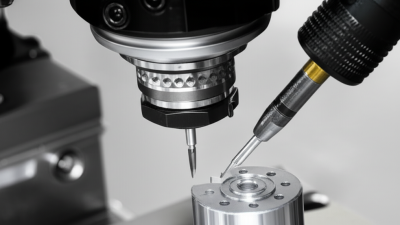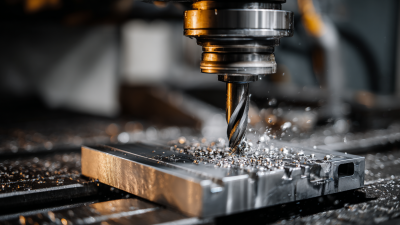How to Achieve Precision with Aluminum Machining Techniques
Aluminum machining has become a critical process in modern manufacturing, as industries demand high precision and efficiency in their operations. As lightweight yet durable materials, aluminum components are integral to sectors such as aerospace, automotive, and electronics, where precision is non-negotiable.

This blog aims to delve into effective aluminum machining techniques that can enhance precision and minimize errors. By exploring various methods, tools, and technologies, readers will gain insight into how to optimize their machining processes. Whether you are a seasoned professional in the machining industry or a newcomer eager to learn the intricacies of aluminum machining, understanding the best practices will empower you to achieve superior results and keep pace with evolving manufacturing demands.
Understanding the Basics of Aluminum Machining: Key Concepts and Techniques
Aluminum machining is an essential process in manufacturing that requires a solid understanding of key concepts and techniques to ensure precision. One of the fundamental elements is recognizing the distinct properties of aluminum, which is lightweight yet strong, making it ideal for a variety of applications. Understanding the material’s machinability can help in selecting the right tools and techniques. For instance, aluminum tends to produce fine chips during cutting, necessitating specific techniques to manage chip flow and prevent issues such as sticking or clogging.
Moreover, various machining techniques, such as milling, turning, and drilling, all require tailored approaches due to aluminum's unique behavior under cutting forces. It's crucial to choose the appropriate feed rates and cutting speeds to achieve optimal results. Utilizing coolant effectively can also enhance surface finish and prolong tool life. By mastering these fundamental concepts and techniques, manufacturers can enhance their precision in aluminum machining, leading to higher quality products and improved efficiency in production.
Essential Tools and Equipment for Precise Aluminum Machining
Achieving precision in aluminum machining requires not just skill but also the right set of tools and equipment tailored for the task. Essential tools include high-quality CNC machines capable of executing intricate designs with exceptional accuracy. These machines are often paired with advanced accessories like precision miter gauges, which facilitate exact cuts, and diamond-coated cutting tools that enhance performance and durability in ultra-precision applications. The integration of AI predictive maintenance in modern CNC systems also helps in preemptively addressing equipment issues, thus minimizing downtime and ensuring consistent machining quality.
In addition to conventional tools, exploring innovative designs can transform the machining process. For instance, new circular saws specifically engineered for metal cutting offer improved efficiency and precision, significantly impacting both the workflow and final product quality. By investing in state-of-the-art manufacturing equipment and staying informed about advancements in tool technology, machinists can not only improve their craft but also enhance the profitability of their projects, setting the stage for success in a competitive market.
How to Achieve Precision with Aluminum Machining Techniques - Essential Tools and Equipment for Precise Aluminum Machining
| Tool/Equipment | Description | Precision Level | Typical Applications | Maintenance Tips |
|---|---|---|---|---|
| CNC Mill | A machine tool that uses computer controls to cut and shape materials with high precision. | ±0.001 inches | Complex parts, prototypes, and small batch production. | Regularly check alignment and keep it clean. |
| Drill Press | A mechanical device utilized to drill precise holes in various materials. | ±0.005 inches | Creating holes with specific diameters and depths. | Lubricate moving parts and check drill bits for damage. |
| Band Saw | Used to make straight or curved cuts with great accuracy and minimal waste. | ±0.01 inches | Cutting complex shapes and profiles. | Ensure blade tension is correct and replace dull blades. |
| Surface Grinder | Machinery used to produce a smooth finish on flat surfaces. | ±0.0005 inches | Finishing flat, parallel surfaces of tough materials. | Keep the machine bed clean and check for wear on the grinding wheel. |
| Tapping Machine | For creating female threads in pre-drilled holes with precision. | ±0.002 inches | Making threaded holes in aluminum and other soft metals. | Maintain taps sharp and lubricate during operation. |
Top Tips for Minimizing Aluminum Machining Errors and Maximizing Accuracy
When it comes to aluminum machining, achieving precision is paramount to ensure optimal performance and quality in the finished products. One of the key ways to minimize machining errors is to invest in high-quality tooling. Using proper cutting tools designed specifically for aluminum can significantly enhance accuracy. Carbide end mills with sharp edges help produce cleaner cuts and reduce burr formation, leading to a finer finish. Regularly inspecting and replacing worn-out tools is also essential to maintaining consistent machining standards.
Another vital tip to maximize machining accuracy is to maintain optimal machine settings. This includes adjusting feed rates and spindle speeds according to the specific aluminum alloy being worked on. Different alloys may require unique approaches; for instance, softer alloys may benefit from faster speeds, while harder ones might necessitate slower settings to avoid overheating and damage. Moreover, ensuring that the workpiece is securely clamped and properly aligned before starting the machining process can prevent vibrations and displacement, which are common culprits of inaccurate results. By focusing on these critical elements, manufacturers can minimize errors and achieve high precision in aluminum machining.
Aluminum Machining Accuracy vs. Techniques
This chart illustrates the error margin associated with various aluminum machining techniques. Techniques like CNC machining and turning have lower error margins compared to manual machining, emphasizing the importance of selecting the right technique for achieving high precision.
Advanced Techniques for Achieving Tight Tolerances in Aluminum Parts
Achieving tight tolerances in aluminum parts is a crucial aspect of machining that demands advanced techniques and precision tools. One of the most effective approaches is utilizing CNC (Computer Numerical Control) machines, as they provide unparalleled accuracy and repeatability. By employing high-speed machining and specialized tooling, manufacturers can reduce surface roughness and enhance dimensional control, ensuring that the final product meets stringent specifications.
In addition to CNC machining, adopting advanced cooling techniques, such as high-pressure mist or flood coolant, can significantly improve the machinability of aluminum. These methods not only reduce thermal deformation during machining but also prolong tool life, providing a consistent finishing quality. Implementing such strategies, along with regular calibration of equipment, can help producers achieve the tight tolerances necessary for high-performance aluminum components in industries ranging from aerospace to automotive.
Best Practices for Maintaining Tooling and Machinery in Aluminum Machining
In aluminum machining, maintaining the precision and longevity of tools and machinery is essential for achieving optimal results. Regularly inspecting and cleaning tools, along with implementing proper storage methods, prevents the buildup of contaminants that could lead to wear and inaccuracies. Moreover, using high-quality tooling specifically designed for aluminum can enhance performance and reduce the frequency of replacements.
Integrating advanced technologies—such as online anomaly detection systems—can further improve maintenance practices. For example, recent advancements in intelligent manufacturing have showcased how predictive monitoring can identify potential issues before they escalate into significant problems. By adopting such systems, machining facilities can enhance their operational efficiency and significantly reduce downtime, ensuring that the machinery operates at peak performance. This proactive approach not only saves costs but also maintains the precise quality that aluminum machining demands.
Related Posts
-

Solutions for Efficient Laser Cut Aluminum Manufacturing in a Competitive Global Market
-

What Makes Metal CNC Machines Essential for Modern Manufacturing
-

10 Essential Tips for Optimizing Your CNC Metal Cutting Process
-

Innovative Uses of Aluminium Sheet Across Diverse Industries
-

Ultimate Guide to Mastering CNC Turning Techniques for Precision Engineering
-

Innovative Tube Laser Cutting Solutions for Enhanced Manufacturing Efficiency